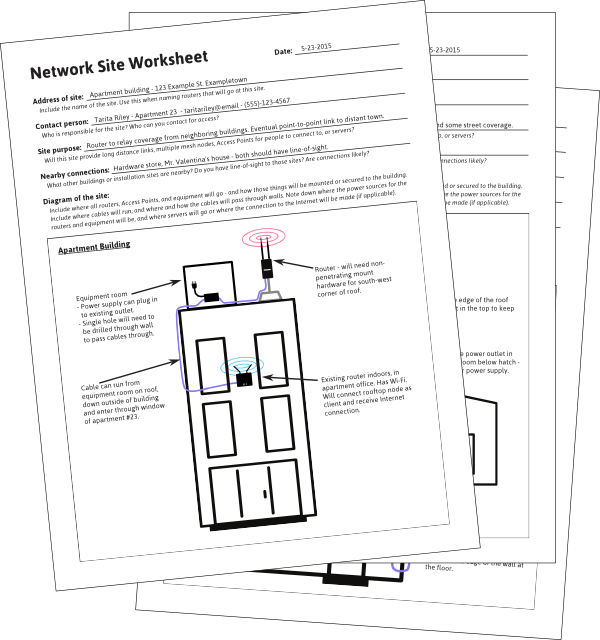
Introduction
When it comes time to design and build your community wireless network, it is helpful to have as much detail about each installation site before you visit. The document below describes some helpful tips for router placement on, in, and around buildings based on what those routers do. After that, there is a Network Site Worksheet to download and use when surveying sites for installations. To best use this worksheet, there are examples of different types of sites and how to use the worksheet.
This process should normally come after you Inventory the Neighborhood, and decide what sites seem best. The worksheets will give you the necessary detail to see what sites can connect, what types of routers you should use, and what hardware and tools the site installation will require.
A Build-It-Ourselves Guide to Community Networks Reading through this document and the worksheet examples should take about 30 to 45 minutes. Visiting a possible installation site to fill out the worksheet may take up to an hour, depending on the size of the site, and the difficulty to reach different areas of the site.
MATERIALS + SUPPLIES NEEDED
- PDF or printed versions of the Network Site Worksheet and Site Worksheet Examples.
- Pens or color markers.
Site planning worksheets

From here, you can start taking a closer look at the sites you are planning to install your community network equipment in and on. Consult the Prep and Install Rooftop nodes, Learn Rooftop Basics, and Learn About Rooftop Mounts documents if you are still looking for more tips on installing on rooftops.
For the most part, installing wireless equipment on rooftops and indoors should be common sense. When you visit a site it will most likely be very clear where the best spot for the equipment will be, where the cables can be run, and where the indoor access points will go so people can access the network.
Download the Network Site Worksheet and print enough copies for the sites you will visit and install. Look through the Site Worksheet Examples to get an idea of what to look for, and how to fill them out.
Definitions
AP (Access Point): A device that allows wireless devices to connect to a wired network using Wi-Fi or related standards.
Ethernet: A type of networking protocol - it defines the types of cables and connections that are used to wire computers, switches, and routers together. Most often Ethernet cabling is Category 5 or 6, made up of twisted pair wiring similar to phone cables.
Line of Sight: An unobstructed path for wireless signals to travel between buildings or devices.
Mast: A metal pipe or pole used to mount equipment. It is usually 1 & 1/2” (4cm) in diameter, and around 5 feet (1.5 meters) long. Antenna masts will often have one tapered end so they can be stacked to form taller masts.
Site: A location in a neighborhood or community to place wireless equipment.
Related Information
As mentioned above, there are a number of other documents related to site planning and installation in the Planning and Building + Mounting sections. You can start with Inventory the Neighborhood, then explore Learn Rooftop Basics and Prep and Install Rooftop nodes before using the worksheets discussed here.
You can also consult Common Hardware Setups and Advanced Hardware Setups for more examples on how to connect wireless equipment together for community networking. In addition, Types of Wireless Networks details more methods for connecting your neighbors!


